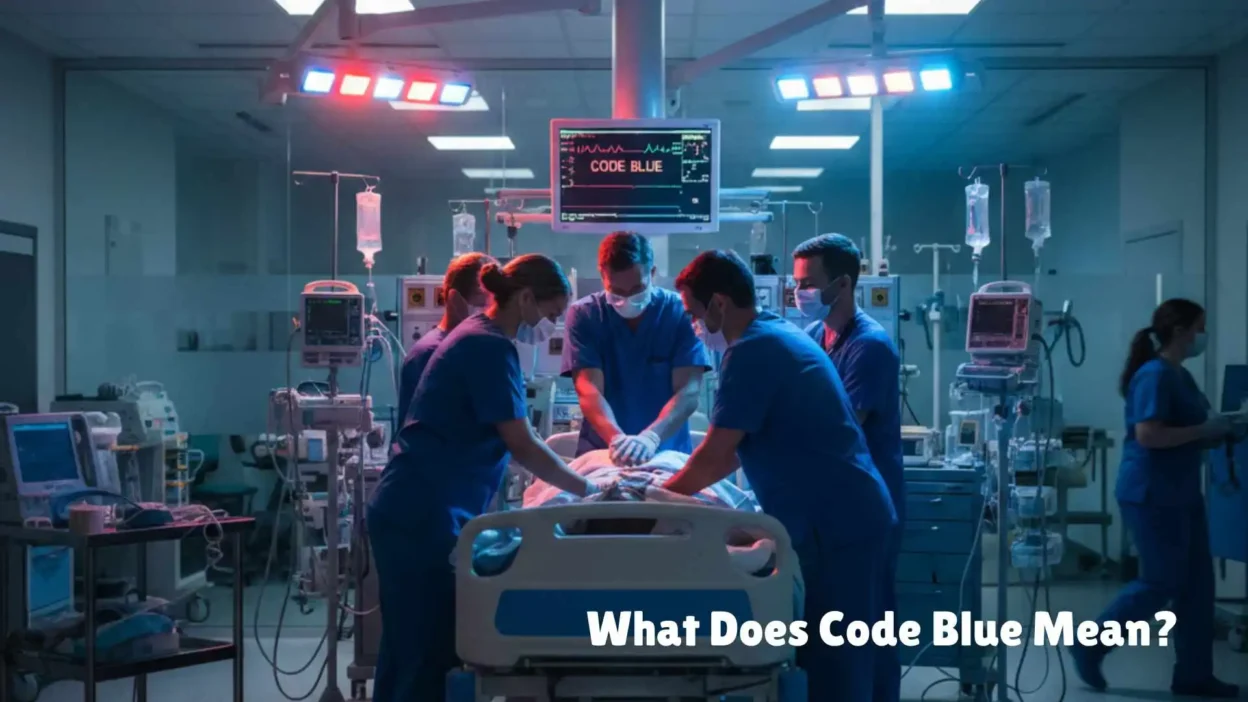In hospitals, every second counts. Code blue is more than just a term you hear in TV shows—it’s a life-saving alert signaling a medical emergency that demands immediate action.
Whether it’s a sudden cardiac arrest or respiratory failure, understanding what code blue means, how it works, and the teams involved can save lives.
This guide dives deep into code blue, related emergency codes, hospital procedures, staff roles, equipment, and outcomes.
Medical & Emergency Codes Explained
Hospitals use emergency codes to communicate critical situations quickly and efficiently. Each code has a specific meaning and allows staff to respond promptly without alarming patients or visitors unnecessarily.
Code Blue
- Definition: A code blue is an emergency alert indicating a patient is experiencing cardiac or respiratory arrest and requires immediate resuscitation.
- Typical scenarios: Sudden collapse, absence of pulse, or inability to breathe.
- Response: Activation of the resuscitation team, immediate CPR, and potential defibrillation.
Other Emergency Codes in Hospitals
| Code | Meaning | Common Use |
|---|---|---|
| Code Pink | Infant or child abduction | Prevents unauthorized removal of a child |
| Code Brown | Hazardous spill or contamination | Chemical or biohazard emergency |
| Code Adam | Missing child within hospital | Similar to Code Pink but broader in scope |
| Medical Emergency | Adult patient crisis | Heart attack, stroke, or severe trauma |
Fact: While codes vary slightly by hospital, standardization is common in the U.S., Canada, Australia, and New Zealand to ensure staff can respond effectively in all facilities.
Immediate Response Procedures
A code blue triggers a highly coordinated emergency response. Hospitals follow precise steps to maximize patient survival.
Activation of a Code Blue
- Staff member discovers the emergency.
- Hospital announcement or overhead alert is made: “Code Blue – Room 305.”
- Resuscitation team immediately responds, including nurses, doctors, and respiratory therapists.
Step-by-Step Emergency Response
- Assess the patient’s condition: Check pulse, breathing, and consciousness.
- Call for help: Activate the code blue team via hospital communication systems.
- Begin CPR: Chest compressions at a rate of 100–120 per minute.
- Airway management: Prepare for intubation or bag-mask ventilation.
- Administer oxygen and medications: Epinephrine, Amiodarone, Vasopressin, and Lidocaine are commonly used.
- Defibrillation if required: Use an AED or manual defibrillator.
Tip: Rapid response, often within 3–5 minutes, is critical for patient survival.
Life-Saving Interventions & Equipment
Successful resuscitation during a code blue relies on trained staff and essential medical equipment.
Cardiopulmonary Resuscitation (CPR)
- Chest compressions: Push down 2 inches deep at a rate of 100–120 per minute.
- Rescue breaths: Deliver 2 breaths after every 30 compressions if trained.
Airway Management
- Intubation: Insertion of a tube into the trachea to secure airway.
- Bag-mask ventilation: Provides oxygen when patient cannot breathe independently.
- Tube insertion and oxygen delivery: Ensures oxygen reaches the lungs efficiently.
Defibrillation
- Manual defibrillator: Requires trained provider to analyze heart rhythm.
- Automated External Defibrillator (AED): Can be used by trained staff or even visitors in some hospitals.
- Life-saving shock: Restores normal heart rhythm in cases of ventricular fibrillation or pulseless ventricular tachycardia.
Medications Used During Code Blue
| Medication | Purpose |
|---|---|
| Epinephrine | Increases heart rate and blood flow during arrest |
| Amiodarone | Stabilizes heart rhythm during arrhythmias |
| Vasopressin | Improves blood pressure during resuscitation |
| Lidocaine | Reduces abnormal heart rhythms during cardiac arrest |
Crash Cart Essentials
- Defibrillator / AED
- Medications listed above
- Intubation equipment
- Bag-mask ventilation kit
- Suction devices
- Emergency airway supplies
Fact: Crash carts are strategically placed on every hospital floor for immediate accessibility.
Code Blue Team & Roles
Team coordination during a code blue is crucial. Each member has a clearly defined role.
Who Responds During a Code Blue
- Healthcare providers: Nurses, physicians, and respiratory therapists.
- Code blue/resuscitation team: Specialists trained in emergency response.
- Clinical staff and support personnel: Assist with logistics, documentation, and equipment.
Role of Dispatch and Communication
- 911 dispatcher: Coordinates external support if needed.
- Internal announcements: Alert all necessary staff while maintaining calm.
Assigning Duties During a Code
- Compressions: Typically performed by nurses or trained staff.
- Airway management: Handled by respiratory therapist or physician.
- Medication administration: Assigned to a nurse.
- Documentation: Ensures proper records of the event are kept.
Tip: Well-defined role assignment improves efficiency and patient survival rates.
Hospital & Facility Context
Code blue emergencies occur in specific hospital settings where patients are most at risk.
Critical Areas
- ICU (Intensive Care Unit): High-risk patients with life-threatening conditions.
- Hospital wards / patient rooms: Where sudden cardiac or respiratory arrest may occur.
- Emergency department: Frequent site of code blue activations.
Other Facility Considerations
- Visitor management: Ensures safety and prevents interference.
- Department protocols: Vary by hospital unit.
- Accessibility: Elevator and hallway arrangements for quick team response.
Timing & Frequency
Response Time Standards
- 3–5 minutes is considered the critical window to save life.
- Regular drills ensure that teams are prepared at the beginning of each shift.
Frequency of Code Blue Events
- Adult patients in hospital wards and ICUs experience code blue more frequently than pediatric patients.
- Survival rates: Approximately 15–20% in general wards, higher in ICUs due to rapid intervention.
Risks, Outcomes & Patient Survival
Risks During Code Blue
- Delay in CPR or defibrillation can lead to permanent brain damage or death.
- Complications may include rib fractures during chest compressions or airway injury.
Survival Factors
- Quick initiation of CPR and defibrillation.
- Presence of a skilled healthcare team.
- Effective medication administration.
Long-Term Outcomes
- Post-resuscitation care in ICU is critical.
- Continuous monitoring ensures patient stability and recovery.
- Early rehabilitation improves quality of life post-arrest.
Geographic & Institutional Variations
- Regional differences: Codes may differ slightly by hospital or country.
- Examples:
- Cleveland Clinic – uses standardized emergency codes across all departments.
- Ohio Health Care Association – trains staff in uniform response protocols.
- Importance of training and preparedness: Staff must be familiar with local and national standards to avoid confusion.
Additional Considerations & Modern Practices
NLP and AI in Code Blue Management
- Automated announcements improve speed and accuracy.
- Semantic labeling of events helps track emergencies for training and audit.
- Role standardization: Clear assignment reduces human error.
Emergency Preparedness Tips for Hospitals
- Conduct regular drills for all staff.
- Update emergency policies frequently.
- Evaluate resuscitation team performance after each code.
- Ensure equipment readiness, including crash carts, AEDs, and medications.
Conclusion
A code blue signals a life-threatening emergency requiring immediate action. Skilled teams, rapid response, and proper equipment save lives. Awareness and training improve outcomes. Understanding hospital codes ensures readiness for any crisis.




